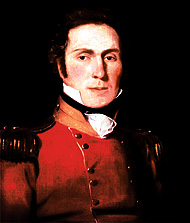Patrick Logan
Captain Patrick Logan (* 1791 in East Renton , Berwickshire , Scotland ; † October 1830 near Moreton Bay , Queensland , Australia ) is the most famous commander of the Moreton Bay convict colony in Queensland, Australia. He was in command of the penal colony from 1826 to 1830, when he was murdered by strangers on an expedition. He was a very good administrator, commander and researcher, but he is best known for his brutality in dealing with prisoners.
Patrick Logan's way to Moreton Bay
Patrick Logan was born in East Renton, Scotland, in 1791, the youngest son of Abraham Logan and Janet Johnstone. His father was a farmer and landowner. In 1810 he joined the 57th regiment of foot soldiers and was promoted to lieutenant after a few years. After defeating Napoleon in Waterloo and ending hostility in Europe, the British military had too many young officers and salaries for many were cut in half. It was only after the death of his father and the inheritance that came with it that he bought the rank of captain and married Letitia O'Beirne, with whom he had two children, Robert Abraham Logan and Letitia Bingham Logan.
In 1824 the 57th Regiment was commissioned to monitor various transports of convicts to Australia. In April 1825, Patrick Logan and his family arrived in Sydney on board the Hooghly . The first two years were uneventful until the 57th Regiment was ordered to Moreton Bay, near Brisbane , to relieve the 40th Regiment, and Patrick Logan was promoted to command.
Captain Patrick Logan changes Moreton Bay
When Captain Patrick Logan took over the reins of Morton Bay, the Moreton Bay penal colony was no more than a few shacks and numbered 200 convicts. However, over the next four years that number quintupled and Patrick Logan demonstrated his skills as the warehouse administrator. He built a settlement of brick houses, complete with a school and hospital. On research expeditions he discovered a large part of the area around his penal camp, today the Logan River bears his name. After his death, a settlement was also named after him, now known as Logan City .
Logan's brutality
The dark side of his personal success and the long years in the military was his unscrupulous dealings with the convicts. 150 lashes or death by slow hanging were not uncommon as normal punishments and prisoners were often beaten to death. Moreton Bay was a hellhole under Patrick Logan, many of the prisoners were forced to kill each other so they could avoid his punishments. Not even his soldiers were safe from him, they were also frequently flogged and were nicknamed "The Steelbacks". Patrick Logan himself was nicknamed "The Tyrant of Brisbane Town" and was immortalized in songs by the oppressed. Another song was written about Logan and Moreton Bay in 1999:
| Excerpt from Moreton Bay by The Volunteers |
| In a place called Moreton Bay |
| The Commander's name was Patrick Logan |
| No worse butcher born in Hell had this world ever seen |
| He flogged them with the cat 'til the bones showed through their backs |
| German translation: |
| In a place called Moreton Bay |
| The commandant was called Patrick Logan |
| The worst butcher from hell the world has ever seen |
| He hit her with the whip until the bones protruded from her back. |
It was his brutality that earned him a place in the Australian history books and not his successes as a commander and researcher.
His death
At the end of 1830 his command at Moreton Bay was to be completed. But before he returned to Sydney with his family, he wanted to go on one last expedition, in the Brisbane River and Stanley River region . The research trip was actually already over when Patrick Logan separated from the rest of the group and wanted to do some last research on his own. He was never seen alive again. Four days later, when he still hadn't shown up, a search party was dispatched, but all they found was his body, naked, in a shallow grave, with his head battered and a spear wound on his back. To this day, there is still no agreement on who was responsible for his death. There are two theories: 1. Escaped convicts murdered him in revenge for his brutal treatment. 2. Australian natives, Aborigines who had lost land and hunting grounds to him, killed him.
Web links
- Entry in the Australian Dictionary of Biography (English)
- Patrick Logan and the early Explorers (PDF file; 243 kB)
- Morton Bay; Folk song; lyrics
- The Volunteers - Moreton Bay; lyrics
| personal data | |
|---|---|
| SURNAME | Logan, Patrick |
| ALTERNATIVE NAMES | Logan, Captain Patrick (full name) |
| BRIEF DESCRIPTION | British commander of a penal colony in Australia |
| DATE OF BIRTH | 1791 |
| PLACE OF BIRTH | East Renton , Berwickshire , Scotland |
| DATE OF DEATH | October 1830 |
| Place of death | at Moreton Bay, Queensland , Australia |
